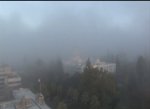
BERKELEY-
The lack of fog this winter may be a nice reprieve for morning drivers, but the layer cool air is necessary for Northern California’s cash crops.
According to researchers at the University of California, Berkeley, winter tule fog has declined dramatically over the past three decades, and is now raising a red flag for the agricultural industry.
Crops like almonds, pistachios, cherries, apricots and peaches go through a dormant period in the winter that is necessary for their growth; the winter tule fog, a thick ground fog that descends on the Central Valley between late fall and early spring, helps these plants reach that dormant state.
“An insufficient rest period impairs the ability of farmers to achieve high quality fruit yields,” Study lead author, and biometeorologist Dennis Baldocchi stated in a press release.
The study was published last week. The group UC Berkeley compared data from NASA, NOAA and a network of University of California weather stations for 32 years. They found, on average, between November and February each year, a 46% drop in the number of fog days over the last three decades.
“Generally, when conditions are too dry or too wet, we get less fog. If we’re in a drought, there isn’t enough moisture to condense in the air. During wet years, we need the rain to stop so that the fog can form,” Baldocchi said.
He also stated fruit developers are already trying to create plants that can tolerate less winter chill, and farmers may need to consider moving their crops to regions more prone to fog, like the foothills.





